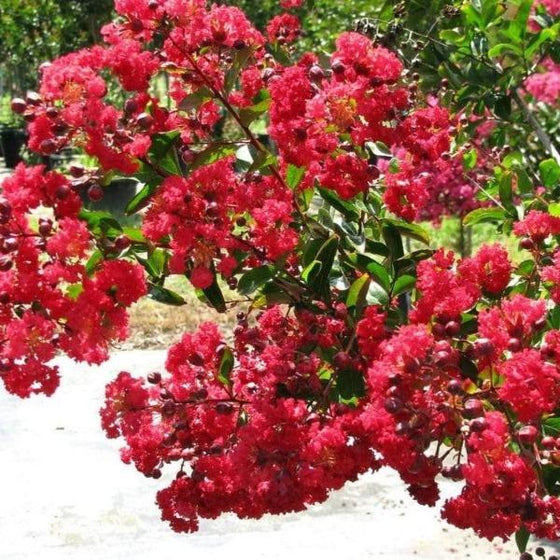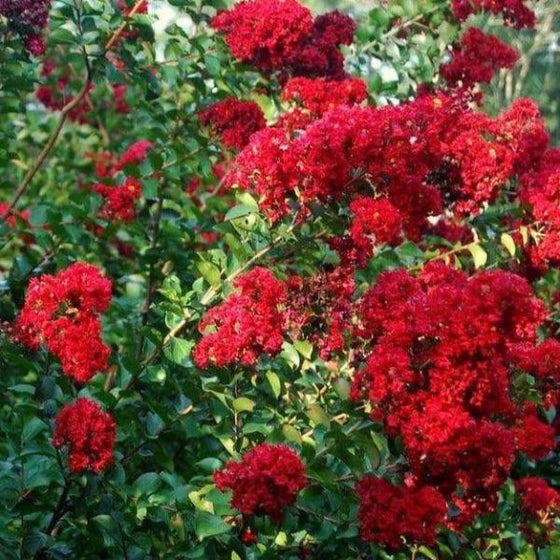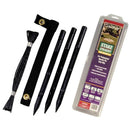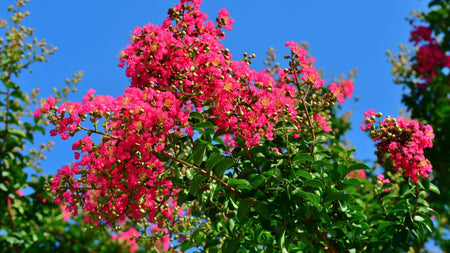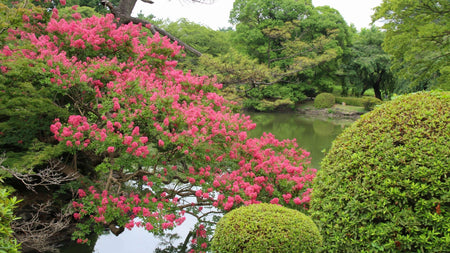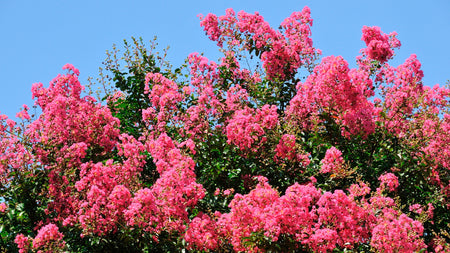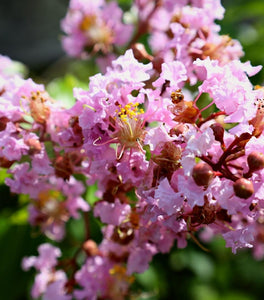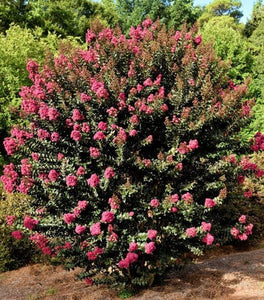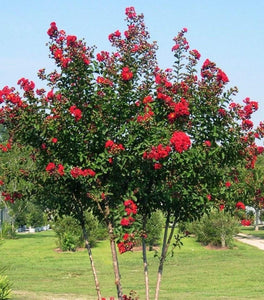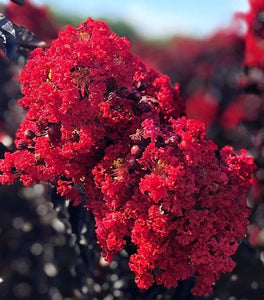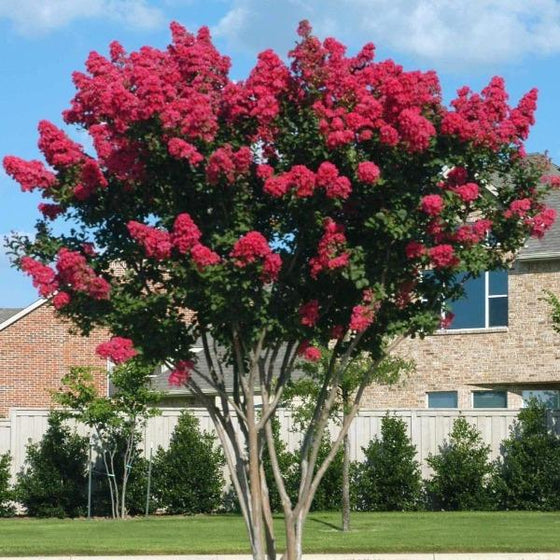
Images Depict Mature Plants
Dynamite Crape Myrtle Tree – Deep Red Summer Blooms on a Fast-Growing Flowering Tree
Explosive color, effortless beauty.
True to its name, the Dynamite Crape Myrtle explodes with rich, crimson-red flowers that bloom for up to four months each year. Its massive flower clusters ignite the landscape with vibrant color from early summer to fall, transforming your yard into a dazzling display. This variety is one of the most vivid red-flowering trees ever developed, offering long-lasting blooms and glossy green foliage that shines all season.
Fast growth and year-round interest.
Reaching 15 to 20 feet tall and growing up to 3 feet per year, Dynamite is one of the fastest-growing Crape Myrtles you can plant. Its smooth, cinnamon-colored bark provides striking texture during winter, while its rich green leaves transition to orange-red in fall. This combination of multi-season beauty and vigorous growth makes it ideal for borders, driveways, or standalone specimen trees.
Low-maintenance and highly resilient.
The Dynamite Crape Myrtle thrives in full sun and well-drained soil, performing best in USDA Zones 7–9 but hardy enough for protected spots in Zone 6. Once established, it becomes drought-tolerant, deer-resistant, and highly disease-resistant, fending off powdery mildew and leaf spot with ease. If you want color that endures summer heat without constant care, this tree delivers.
Perfect for any landscape design.
Whether planted as a focal-point tree or in rows for a flowering privacy screen, Dynamite’s upright shape and blazing color make it one of the best red varieties available. Pair it with Natchez White Crape Myrtle for contrast or line your driveway with alternating varieties for a designer look. Each year, it rewards you with reliable blooms, strong structure, and head-turning curb appeal.
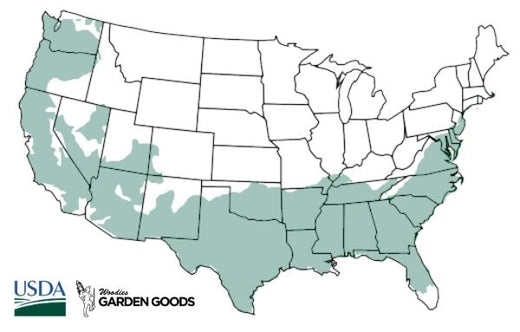
| Hardiness Zone: | 7-9 |
|---|---|
| Mature Height: | 15 to 20 feet |
| Mature Width: | 12 to 15 feet |
| Classification: | Multi-stemmed Tree form large (20 feet or more) |
| Sunlight: | Full sun |
| Habit: | Deciduous, densely branched, multi-stemmed habit |
| Flower Color: | Bright fiery red flowers in mid to late summer through the first frost |
| Foliage: | New growth emerges a rich glossy green, changing to a equally vibrant orange-red in the fall |
| Soil Condition: | Any well drained soil |
| Water Requirements: | Water well until established |
| Uses: | Extremely attractive when used as a focal point in the mixed border, mass planting, or a specimen planting. Also try them in large containers on the patio. |
How to Care for Dynamite Crape Myrtle
Once you buy a Dynamite Crape Myrtle Tree, make sure to read about the care instructions that are recommended to keep this plant healthy and thriving.
How do I plant a Dynamite Crape Myrtle?
Choose a sunny location with at least 6–8 hours of full sun per day. Dig a hole twice as wide as the root ball but only as deep. Loosen the soil, position the tree so the top of the root ball sits level with the ground, and backfill with native soil. Water thoroughly and apply 2–3 inches of mulch to help retain moisture. Avoid planting in waterlogged areas or heavy clay soil without amending for drainage. Crape Myrtles prefer slightly acidic to neutral soil and benefit from compost or slow-release fertilizer at planting time.
How often should I water my Dynamite Crape Myrtle?
Water deeply once or twice weekly during the first year to help the tree establish a strong root system. After that, Dynamite is drought-tolerant and requires only occasional watering during extended dry periods. Always water at the base of the tree rather than overhead to reduce fungal issues. A 2–3 inch mulch layer around the base (kept away from the trunk) helps regulate temperature and retain soil moisture throughout the summer.
When should I fertilize my Dynamite Crape Myrtle?
Fertilize in early spring with a slow-release balanced fertilizer (10-10-10) before new growth emerges. Avoid high-nitrogen products, which can encourage leafy growth at the expense of flowers. If your soil is poor or sandy, a second light feeding in midsummer will help maintain bloom vigor. Regular feeding supports brighter flowers and denser foliage, making your Dynamite even more impressive.

How and when should I prune a Dynamite Crape Myrtle?
Prune in late winter or early spring before new growth starts. Focus on removing dead wood, weak stems, or any crossing branches. Because Dynamite blooms on new wood, pruning helps stimulate fresh growth and larger flower clusters each season. Avoid “topping” or “crape murder,” which weakens the tree’s natural form. Instead, lightly shape it for height and airflow — this encourages full, balanced flowering and maintains the tree’s natural upright elegance.

